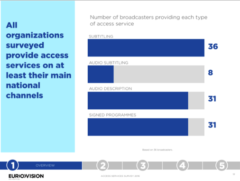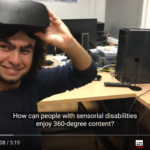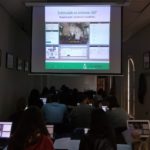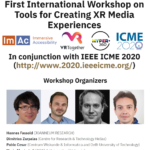Subtitles are the most common and versatile accessibility service across broadcast and broadband media services. Subtitles have expanded from between languages to same language subtitles, subtitles for the deaf and hard of hearing, and verbatim transcriptions. Likewise, subtitles can also become a hybrid access service when generated based on Easy-to-Read guidelines, or when are read aloud. The latter case is known as Audio Subtitles (AST), or spoken subtitles/captions, which is defined by ISO/IEC 20071-25 as “captions/subtitles that are read aloud over the audio in a video”. According to a recently published survey by the European Broadcasting Union (EBU 2016), AST is the least deployed access service in Europe, as shown in the figure below.
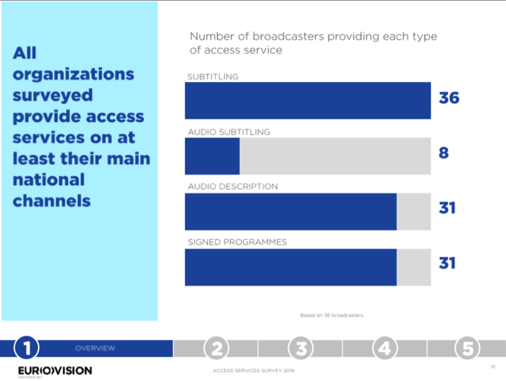
Figure 1. Access services provided by the 36 public European broadcasters surveyed in (EBU 2016)
The growing legal pressure in Europe to offer more accessibility in the audiovisual domain has been greeted with interest by stakeholders of the value chain. The deployment and maintenance of new services mean extra costs, but AST is an ecological and cost effective access service, since it can take advantage of existing subtitling assets, recycling and giving another use to them.
ImAc has conducted a comprehensive research study in this context. First, potential scenarios and use cases in which AST become beneficial have been compiled and analysed. Second, unlike existing literature that has analysed AST from a theoretical perspective, the key technological aspects required for AST and the provided solutions by European broadcasters have been reviewed. Based on such analysis, requirements for AST and potential workflows to deploy them have been derived and proposed, respectively. The proposed solutions share a fundamental premise: audio subtitling is a complement to audio description, not a substitution.
The gathered requirements, use cases and proposed solutions have been shared with the World Wide Web Consortium (W3C) Timed Text Working Group Charter (TTWG), chaired by Nigel Meggit (BBC). This will hopefully impact the specification of new, and/or extensions to existing, standard solutions and formats for AST. Likewise, these research contributions have been also submitted for publication in a high-impact journal. A third action has been taken within this umbrella: the organization of a “Conference Day on Audio Subtitles” to be held in Barcelona (at CCMA premises) on March 4th, 2019. This event will gather relevant actors and stakeholders along the value chain in Europe, like broadcasters, standardization bodies, regulators, researchers and manufacturers.
Similar research efforts are being devoted for all access services considered in ImAc, with the final goal of contributing with standard-compliant and high-quality accessibility solutions for immersive media. The conducted activities and insights for the additional access services will be shared in future posts.
Reference (EBU 2016): European Broadcasting Europe (EBU) Access Services Paneuropean Survey https://www.ebu.ch/files/live/sites/ebu/files/Publications/Presentations/EBU%20Access%20Services%20Survey%202016.pdf Published in 2016. Last access in January 2019
Authors: Pilar Orero (UAB) and Mario Montagud (i2CAT)

